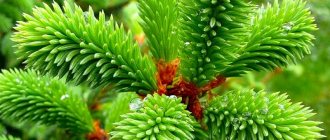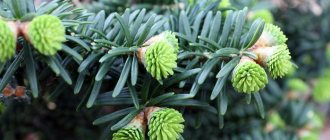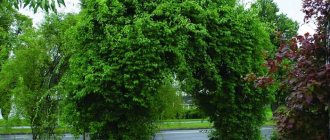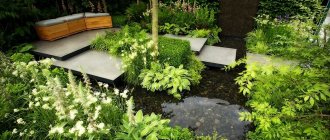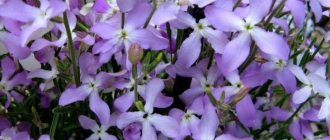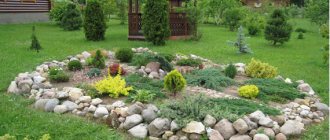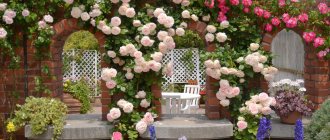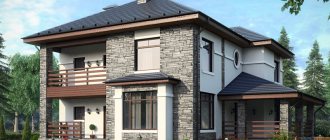A hedge is an excellent alternative to a conventional fence. This is an excellent element of landscape design that hides the area from prying eyes, serves as a screen from dust and wind, and performs a security function. An evergreen hedge not only pleases the eye, but also makes the space more harmonious.
When choosing plants for a hedge, you should consider the following factors:
- Desired fence height.
- Purpose.
- Climatic conditions.
- Features of the site (soil type, lighting, humidity).
Evergreens can be considered universal: pea cypress, thuja, boxwood, juniper, dwarf or Serbian spruce, balsam or single-color fir.
Fast-growing shrubs for hedges: elderberry, forsythia, euonymus, currant, mock orange, cotoneaster, honeysuckle, sloe, privet, hawthorn, roses, broom, Thunberg barberry. If the choice fell on a single-tier high hedge, you can choose trees - maples, poplars, willow, linden, rowan, turf, buckthorn, chokeberry, hazel, lilac and others.
Ideas for using hedges
Landscape designers use green spaces as low borders. It emphasizes the curves of paths and architectural objects, flower beds and fountains. Living decoration is also suitable for decorating a pond or playground. What is the best hedge to use as a border:
- cowberry;
- Thunberg barberry;
- boxwood;
- Lawson cypress;
- dwarf caragana.
A “border” of plants.
On a large area, plantings can be used to zone the space. Separate the recreation area from the garden or vegetable garden. Designers advise choosing shrubs with a height of up to a meter. This will avoid creating unnecessary shadow. Planted in parallel, symmetrically, wavy.
Standard rectangular shapes surprise no one. Shrubs for hedges can take a variety of shapes. Even a novice gardener can do cubes, arches, waves. Masters of their craft embody images of animals using garden shears. Such compositions require frequent maintenance.
Designer flower beds
Using plantings as a design accent is a great option. Colorful multi-level structures transform any area. Red-leaved boxwood and blue spruce are often combined. To maintain an attractive appearance, experts recommend choosing perennial plants of a contrasting shade.
If the area looks bland, then it is good to use flowering plants. Spiraea, currant and hawthorn bloom from several weeks to a month. By combining large plants with low borders, you can get compositions that bloom all year round.
Properly selected plants are the key to beautiful flower beds all year round
Eclecticism is trending not only on fashion catwalks. Hedging bushes are combined not only with sculptural compositions. The following solutions also apply:
- gabions;
- large stones;
- boulders;
- fences;
- wooden modules;
- brick pillars.
Green plants will help “restore” an old fence. Climbing or tall plants are useful for this purpose. The wire structure will allow you to create a hedge of clematis, hydrangea, honeysuckle, grapes and wisteria. Climbing roses are especially beautiful.
Path of roses
See also: Catalog of companies that specialize in landscaping work on sites.
Description
Such a fence will not only hide you from prying eyes and delight you with beauty, but will also enrich the air with oxygen. In conditions of air pollution, green space will be an excellent solution . The article will help you choose plants for her. He will tell you how to plant and how to care for them.
An example of a combination of plants for a hedge
A hedge can consist of almost any plant. When selecting them, you need to take into account the characteristics of care and growth periods. If you don’t want to wait for them to grow, then you need to give preference to fast-growing specimens.
Types of living fencing:
- Up to 1 m – curb
- 1 – 3 m – fence
- Above 3 m – wall
TOP fast-growing shrubs for creating a hedge
In landscape design, a “fence” of green spaces is usually divided into two types: formalized and unformed. The latter is used extremely rarely, as it gives the site a neglected appearance. Fast-growing hedge shrubs will transform your landscape in a short time.
- Dogwood , with proper care, reaches 3-4 meters in height. It blooms from March to April, then blooms leaves and fruits. A well-lit area is suitable for growing. When buying an annual plant, you need to understand that dogwood grows slowly, and a two-year-old seedling grows more actively.
Dogwood hedge
- The bladderwort is unpretentious in care. It is important that the water at the roots does not stagnate, otherwise the plant will die. It reaches four meters in height, but dwarf shrubs up to a meter are suitable for creating a neat hedge. Over the course of a year, he gains 35-38 cm in height. Maintains an attractive appearance throughout the season.
Bladderwort hedge
- Snowberry belongs to the genus Honeysuckle. Bluish-green leaves, white flowers with a pink tint are complemented by berries. The hedge looks very unusual and elegant. This shrub is suitable for plantings no more than 125-130 cm in height.
Advice! The snowberry is unsuitable for a formalized hedge with clear edges. For this purpose it is better to choose another option.
- Hawthorn is simply created for a hedge. It grows quickly, lives for three hundred years and is unpretentious to living conditions. At the gardener’s request, you can create either a sparse “wall” or a dense dense hedge. Designers advise planting exclusively in a checkerboard pattern.
Hawthorn hedge
Only three-year-old plants are suitable for planting. Two years after planting, the bush is heavily pruned, leaving 20 cm branches. This will lead to an increase in the density of the future hedge.
Blackberry
Very often, gardeners use blackberries as a fence plant. It does not grow without watering, but can withstand the most severe frosts. With proper care it produces a bountiful harvest. With its thorns it protects the area from uninvited guests.
However, it is the thorns that interfere with harvesting. If new shoots are not trimmed in time, the blackberry bush will look rather unattractive.
TOP evergreen shrubs for hedges
If you need a fast-growing perennial evergreen hedge, then thuja is an ideal option. There are more than a hundred different species, among which are smaragd and brabant .
Annual growth is up to 30 cm. You can create a rarer evergreen “fence” or a dense one. In the latter case, thuja is planted every 50cm.
Dense fence made of thuja
Boxwood grows more slowly, barely reaching 20 cm annually. But gardeners love the plant for its ease of care and resistance to different weather conditions. The plant allows you to create a dense hedge up to a meter high.
Advice! The plant is thermophilic. Before the onset of frost, it should be covered.
Juniper is a favorite of landscape designers. The plant likes to be in the shade and is resistant to frost and precipitation. A fast-growing perennial juniper hedge does not require frequent watering. Planted at a distance of 60 cm. Spreading varieties are preferable for decorating borders.
Juniper hedge
Privet is considered an evergreen plant suitable for creating a hedge . Glossy elongated leaves with snow-white flowers. Closer to autumn, small berries of a characteristic blue color appear. For a decorated green “fence” it is suitable only with regular pruning over a long period of time. More often used for the unformed version.
Privet does not like careful design
Yew is a berry version of pine needles. It is odorless due to the absence of emitted resin. Suitable in landscape design for creating hedges. It differs in that:
- easy to care for;
- holds its shape for a long time;
- withstands heavy pruning;
- Any shape can be realized from it.
A hedge made of yew bushes is suitable for decorating a summer cottage and the territory of a hotel, restaurant, or park. Low and dense green “walls” look neat and tidy. A strong root system does not require frequent loosening of the soil and special fertilizers. Resistant to temperature changes. Yew does not grow as fast as other conifers. But the shape lasts for a very long time.
Yew hedge
Barberry
We recommend paying attention to this shrub. True, it does not grow quickly, but in a few years the plant will create a two-meter impenetrable living fence in the country with huge thorns.
In the fall, barberry will delight the owners of the dacha with a bountiful harvest and purple foliage. The shrub does not sprout and there is no need to waste time and effort on cutting off excess shoots.
Shrubs that do not require regular trimming
It is convenient to use plants that do not need to be constantly trimmed to maintain an attractive shape. What is the best material to make a hedge from:
- kalmia;
- Spiraea Wangutta;
- caragana bush.
Kalmia bushes take root in loose soil. The plant cannot be called unpretentious. If water stagnates, the root system will quickly rot. Does not grow more than one and a half meters. The evergreen plant is distinguished by its unusual bright flowering in late spring.
Spiraea Vangutta is a large plant. Requires a lot of space, and therefore is not suitable for a small area. Beautiful bluish leaves, white flowers. The crown grows up to two meters in diameter.
Hedge Spirea Vangutta
Shrubby caragana takes root in areas with uneven surfaces. Differs in the shape of the leaves. The golden-hued flowers highlight the deep green of the foliage. It is easy to care for; caragana is resistant to temperature changes and tolerates heat and frost.
A bright yellow hedge will be made from forsythia . An amazing plant, which is one of the first to become covered with inflorescences and pleases its owners for more than a month. It consists of thin branches that allow you to give the bush any shape. A sunny, draft-free place is suitable for planting. You will have to wrap the plant in winter and provide plenty of watering in summer. The shrub is capricious to temperature changes.
Severe frosts will destroy the plant, and it will be impossible to restore the fence. Fertilize with mineral fertilizers in early or mid-spring, and add organic mixtures in the fall. Haircuts are done rarely and carefully. If you cut off all the sprouts that appear, the forsythia may not bloom in the spring.
Advice! It is better to trim forsythia after the end of the flowering period.
"Wall" of forsythia
Flowers
A living fence in the country can be formed from lilac, jasmine or rose.
Lilac grows very quickly. A very unpretentious shrub with beautiful and pleasantly smelling flowers.
Practically not susceptible to diseases. Produces abundant growth, which should be systematically removed. Without trimming the branches it can reach a height of three meters.
The benefits of green space
A fast-growing hedge gives the area a neat appearance. But aesthetics is not the only advantage. Rich green shades, a pleasant aroma of greenery, the beauty of flowering and shade are an excellent help for plastic and metal structures. In addition, this is an environmentally friendly way to delimit the site.
A wide range allows you to choose any type of plant. They can be used alone or combined with structures, architectural elements, and other colors.
Hedges can be formed into various shapes
Spirea:
It is possible to create a dense wall of living trees by planting willow, beech or hornbeam in a row. Fast-growing vines (honeysuckle, ivy, hops, virgin grapes) are suitable for vertical gardening. In the southern regions, powerful living walls can be created with the help of campsis - this powerful vine produces billions of spectacular flowers per season, but does not winter well without shelter in areas with a harsh climate.
Kampsis
Care of living borders is carried out in accordance with the agricultural technology of growing a particular crop; plants are protected from pests, watered in a timely manner and the necessary fertilizers are applied. Look at the photo - man-made living fences look fresh and natural in landscape compositions.
Don't be greedy, share with your friends;)
Disadvantages of green “fencing”
Despite their unpretentiousness, plants can be susceptible to diseases. Then the aesthetics are completely lost. Improper care or untimely pruning also spoils the appearance. A hedge requires fertilizing, loosening the soil, and watering.
The type of plant will determine the frequency of pruning. Care is selected individually. Not every amateur gardener will agree to spend time maintaining the aesthetic appearance of a green “fence.”
Some types of haircuts are quite difficult to maintain in their original form.
Rose
Most people consider the flower to be capricious and heat-loving, just like a queen should be. In fact, many frost-resistant varieties have been developed today. Some of them can withstand temperatures down to minus 40º C!
The so-called park roses can be used to form a beautiful living fence.
How to create fences from green spaces
The landscape designer communicates with the client and helps select plants. After consultation, a project and an exact drawing are drawn up. It is indicated in advance what types of plants will be placed and in what part of the site. A competent specialist will also indicate possible growth.
Plants for hedges are planted in prepared holes and trenches. The number of rows and bushes is calculated in advance. The soil is changed to a nutrient composition that is suitable for the selected plant. The specialist gives instructions for care and subsequent pruning.
To make the hedge look geometrically correct, careful preliminary calculations are required
Turf
The shrub grows quickly. Reaches a height of three meters and forms dense thickets. Easy to "haircut".
In winter, the foliage falls and the bush loses its decorative effect.
Before planting turf, you should make sure you have water for irrigation. The plant loves water very much.
Creating a hedge from climbing plants
Flowering climbing plants create amazingly beautiful hedges. Use a fence or stretch a mesh as a support. When forming, take into account the method of garter:
- vertical will increase the number of shoots;
- horizontal will increase height gain.
Seedlings are planted in the fall, closer to mid-October, but the creative process of forming a hedge can only begin after two years. Climbing roses are suitable for a luxurious hedge. The only negative is impassability (due to the density of the bushes and the presence of thorns).
Luxurious arches of roses
Currant
Forms dense but low rows. Therefore, you should choose a suitable location based on the height of the plant.
How to preserve the beauty of green spaces
Hedge bushes grow quickly and require careful attention. It doesn’t matter whether plantings are used for zoning space or simply as a decorative element, it is necessary to provide them with regular care.
Haircut is the main element of maintaining the attractiveness of a green “fence”. Prune more often at the end of June after the completion of the active growth stage. Fast-growing privet and similar plants are trimmed again in September.
Advice! Cypress and thuja will not withstand rare pruning. If you prune too infrequently, the heavily cut areas will not recover. Old branches will not produce new shoots. The fence will be hopelessly damaged.
Proper trimming is the key to long-term hedge service.
Experts advise preserving and maintaining the trapezoidal shape of the bushes so that the lower branches receive enough light. Boxwood, yew and other plants that can actively grow in the shade can be trimmed in a rectangular shape.
Spreading shrubs retain their rounded shape well. The upper part is narrower than the lower part. Sun-loving plant species require sufficient sunlight to maintain an attractive appearance.
The plant fence should receive enough sunlight
Deciduous trees
Some plants that grow quickly in the wild grow into huge trees. It is enough to plant them at short intervals and trim the shoots regularly to form a limited, dense hedge of various shapes. There are many trees used for decorative fencing, the most popular types are:
- hornbeam;
- beech.
Photo. Hornbeam hedge
Trees are more demanding to cultivate than deciduous shrubs, but they tolerate not particularly favorable conditions and are resistant to low temperatures. Thanks to them, there is a chance to create a fast-growing hedge in the garden, which looks extremely decorative in the fall, when the leaves turn yellow or red.
Photo. Beech hedge
Landing
Hedge
Before planting hedge plants, you need to prepare the area. Think about what plants will make up the composition, or whether it will consist of one type of shrub.
Preparation of a personal plot
You need to start by marking the territory. It will allow you to plant plants evenly, at the same distance. This is done using a tape measure or pegs with a rope.
A trench is dug along the marks
The depth should be 40 - 60 cm. Depends on the root system of the selected tree or shrub. The width varies by the number of rows. For one row of plantings 60 cm is enough, for two rows 1 m.
Then the soil is prepared. Here you need to take into account the characteristics of plants to the soil. If necessary, a drainage layer of crushed stone is laid on the bottom. The soil is mixed with humus or other suitable fertilizers.
Disembarkation
Planting time depends on the planting material. It is better to plant cuttings in the spring. Shrubs grown in containers or transplanted from another site can be planted both in spring and autumn.
Planting a hedge
The soil is moistened. After this, disembarkation takes place. The distance between seedlings should be approximately 30 cm. It depends on the desired density of the hedge and the characteristics of the plant itself.
The formation of a hedge takes at least 2 years. During this time, the plants are already growing well, creating a dense wall.
